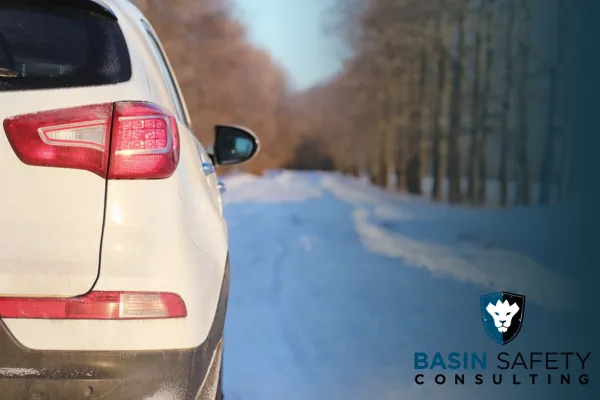Hearing Protection Training

Winter Driving Safety: Tips for Icy Roads
Driving on icy roads can be one of the most dangerous challenges for any driver. Reduced traction, poor visibility, and freezing temperatures can quickly turn a normal drive into a risky situation. Whether you’re commuting to work or managing a fleet of vehicles, knowing how to handle icy conditions is essential for safety.
1. Prepare Your Vehicle Before You Drive
Before you hit the road, ensure your vehicle is winter-ready. Proper preparation can significantly reduce your risk of accidents.
Winter Vehicle Checklist:
Check your tires – Use winter tires or all-season tires with good tread depth.
Inspect brakes – Make sure they respond smoothly and aren’t worn down.
Top up fluids – Windshield washer fluid and antifreeze are essential.
Test your battery – Cold weather drains power faster.
Keep an emergency kit – Include blankets, flashlight, first aid kit, snacks, and jumper cables.
Pro Tip: Always clear snow and ice from your windows, mirrors, lights, and roof before driving. Reduced visibility increases crash risk.
2. Drive Slowly and Smoothly
When roads are icy, slow and steady wins the race. Fast movements—accelerating, braking, or turning—can easily cause you to lose control.
Key Safe Driving Habits:
Accelerate gradually to maintain traction.
Brake gently—never slam your brakes.
Increase following distance—leave at least 6–8 seconds between you and the car ahead.
Avoid sudden steering movements.
If your vehicle starts to skid, stay calm, steer in the direction you want to go, and avoid overcorrecting.
3. Watch for Black Ice
Black ice is nearly invisible but extremely slippery. It often forms on bridges, shaded areas, and intersections.
Spot and Handle Black Ice:
Look for shiny or glossy patches on the road.
Avoid braking hard—ease off the accelerator instead.
Keep your steering wheel straight and stay composed.
Remember: If the temperature is near freezing, assume ice could be present—even if you can’t see it.
4. Stay Alert and Adjust to Conditions
Always stay focused on the road and your surroundings. Even experienced drivers can underestimate how fast conditions change.
Use low beams in snow or fog.
Avoid cruise control—it can cause wheel spin.
Plan extra travel time to avoid rushing.
Stay updated on weather reports before leaving.
5. Know When to Stay Home
Sometimes, the safest decision is not to drive at all. If weather warnings or icy conditions are severe, it’s best to wait until roads are cleared.
Employers, fleet managers, and safety supervisors should encourage workers to prioritize safety over deadlines during extreme weather. A short delay is better than a serious accident.
Conclusion: Stay Safe, Stay Smart
Winter roads demand extra caution, patience, and preparation. By maintaining your vehicle, driving slowly, and staying alert, you can drastically reduce your risk of accidents on icy roads.
At Basin Safety, we provide defensive driving and winter safety training designed to keep employees safe year-round.
👉 Ready to improve winter driving safety for your team?
Contact Us to schedule a Winter Driving Safety Training session
Archives
Categories
Benzene Testing
Bloodborne Pathogens
Breathing Air Systems
Certification Process
Confined Space Attendants
Confined Spaces
Construction Equipment Operators
Electrical
Environmental Compliance
Excavation and Trenching
Fire Extinguisher Training
Forklift Operator
Hazcom Workplace Safety
HAZWOPER
Hearing Protection Training
Heavy Equipment
Hydrogen Sulfide
Lone Worker
Lone Worker Solutions App
Monitoring
Oil and Gas
Oil Drilling
Online Training Confined Spaces
Permit-required
PPE
Radiation Safety
Rescue Equipment
Rescue Team
Safety Consultants
Safety Devices
Safety Tracking
Safety Training
Site Inspections
Training 1
Training 2
Training 3
Training 4
Training 5
Uncategorized
Virtual Access to Safety Data
Waste Haulers
Confined Space Rescue
Mental Health
VISIT US
202 48th Ave SW, Williston, ND 58801
2740 Sims St. Suite B Dickinson, ND 58601
(701) 572-8140

BASIN SAFETY CONSULTING CORPORATION
Basin Safety believes in shared excellence. We are accountable to our core values:
● Pioneering Excellence Everyday
● Supporting each other to put customers first
● Asking the right questions, to ensure the greatest results.
Basin Safety Consulting © 2025. All rights reserved.
Powered By Upleveled Strategies

BASIN SAFETY CONSULTING CORPORATION
Basin Safety believes in shared excellence. We are accountable to our core values:
● Pioneering Excellence Everyday
● Supporting each other to put customers first
● Asking the right questions, to ensure the greatest results.
VISIT US
202 48th Ave SW, Williston, ND 58801
2740 Sims St. Suite B Dickinson, ND 58601
(701) 572-8140
Basin Safety Consulting © 2025. All rights reserved.
Powered By Upleveled Strategies

